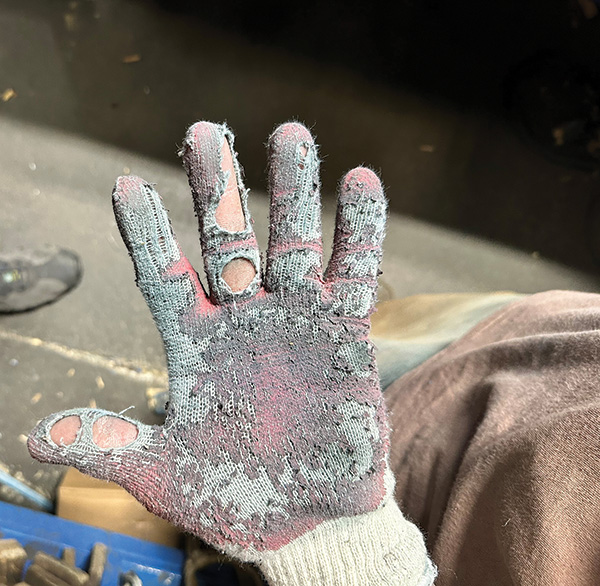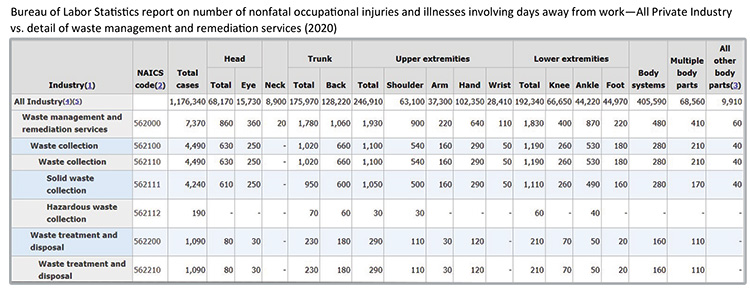Work gloves are the first line of defense against the most common hand injuries facing waste industry workers.
By David Miller
The obvious answer to this question is, “the least amount possible that will still ensure a reasonable level of safety and productivity.” Like most pat answers, the trouble begins when you try to define your terms. It is not so easy to quantify what will ensure a reasonable amount of safety and productivity. To put it another way, we could ask, “What are the consequences of not spending enough on work gloves?”
Many times, we see safety initiatives implemented only after a serious accident has already occurred. This is obviously a bad deal for the victim of the accident, in addition to being a costly mistake for management.
The financial consequence of an injury can affect the balance sheet far more than what might be saved by skimping on work gloves and other safety expenses. There is also an emotional consequence that is somewhat more difficult to express in financial terms. The impact of a significant injury reverberates throughout the workplace, especially if there is a perception that management does not care enough about the welfare of the staff to adequately ensure their safety. The effect of morale on productivity is not something easily quantified, but it is worth keeping in mind as we examine the hard costs that we can quantify.

Image courtesy of HUB Industrial.
Hand Injury Risks in the Waste Industry
According to the U.S. Bureau of Labor Statistics, 10 percent of all reported nonfatal injuries in the Waste Management and Remediation Services sector involve hands and wrists. This is consistent with the ratio across all industries. Keep in mind, these are the reported injuries. There is no doubt a great many more hand injuries that never get reported despite their effect on productivity.
The medical cost of these reported injuries can fall anywhere between $540 and $26,000, and in extreme cases like severed tendons, the total cost of treatment can exceed this limit by a factor of 3. In addition to the
direct costs to the employer, a workplace injury will incur indirect costs in the aftermath (work interruptions, lost productivity, legal and remediation expenses), bringing the real cost of a single incident to $1,600, to $80,000, or more.
Risk Management
Alas, there is no failsafe way to prevent all accidents from occurring, but according to Industrial Safety & Hygiene News (ISHN), hand injuries are among the most preventable.
Reducing the incidence of hand injuries requires ongoing safety training, compliance with OSHA regulations regarding such things as machine guarding and lockout/tagout procedures, ergonomics, and providing your team with gloves appropriately suited to the task.
Work Gloves as an Essential Component of Your Safety Program
Work gloves are the first line of defense against the most common hand injuries facing waste industry workers. Across all industries, 70 percent of all reported hand injuries occur when no gloves were being worn.
Gloves can effectively protect workers against blisters, lacerations, and puncture wounds. A glove with cut-resistant properties will safeguard your hand against cuts when you encounter sharp objects, and gloves with rubber bumpers protect fingers and knuckles from inadvertent impacts. However, they will not magically protect a hand that strays into the path of the pistons of a compactor. That is what machine guards and training are for.

Chart courtesy of the Bureau of Labor Statistics.
Factors that Affect the Cost and Value of the Glove
There are hundreds of work gloves available today, making it challenging to know which ones will be best suited for the tasks your team performs. Prices range from $1 to more than $50 a pair.
A reasonable goal in selecting a glove is to find the glove that most effectively protects workers against the risks they face without paying for features they do not need. Comfort is also a consideration, because a glove that does not feel good to wear
cannot be considered a safe glove even if it is highly rated against the risks your team faces.
Finally, examine glove features and ratings systems. As we understand more about glove construction and how to interpret the relevant ratings, we can become more strategic in selecting the glove that does what is needed and brings the best value. Most likely, your company will have a safety manager or industrial hygiene professional to prescribe minimum standards for your gloves. Additionally, your safety supplier is a valuable resource when it comes to selecting gloves that meet your needs and your budget. | WA
David Miller is the Waste Industry Manager for HUB Industrial Supply (Lake City, FL). He is a Certified Safety Professional and works with managers to effectively implement and manage PPE and MRO programs in the waste industry. He may be reached at [email protected]. HUB Industrial Supply is an Applied MSSSM company.
Source
TABLE R2. Number of nonfatal occupational injuries and illnesses involving days away from work by industry and selected parts of body affected by injury or illness, private industry, 2020 : U.S. Bureau of Labor Statistics (bls.gov)
